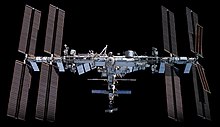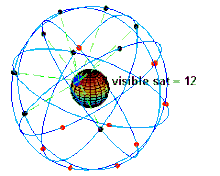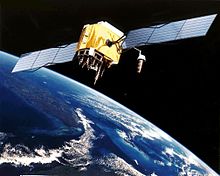Space Technology
Appearance

This learning resource is about Space Technology. First you start with the basic areas:
- Earth Observation and Remote Sensing,
- Telecommunication,
- Global Satellite Navigation,
- Human Spaceflight
Space for Global Health
[edit | edit source]




- Space Medicine on Human Space Flights triggering innovation on medical treatment and analysis. Try to identify scientific evidence in peer-reviewed journals, that show contributions from space medicine to innovation of medical treatment on earth. What are the challenges, constraints, drawbacks and benefits?
- 3D Printing of human tissue[1]: Consider the application scenario of 3D Printing of human tissue on the International Space Station (e.g. when larger area of the skin must be covered by human tissue) and compare that with a support of patients in remote areas, where medical services are not available. Consider also the required time to produce
- 3D printing for pharmaceuticals:[2][3] Identify the rationals for 3D printing of pharmaceuticals in comparison to classical production of pharmaceutical. Can serve 3D printing a service of tailored pharmaceuticals for each patient. What are the challenges for an evidence based design of such an approach? Why is this related to space technology in terms of required drugs for astronauts and can these technologies be developed without space technology?
Learning Task
[edit | edit source]- (Sustainable Development Goals)[4] How can Earth Observation (EO) be used to measure implementation and accomplishments of objectives for specific sustainable development goals? Select a specific SDG e.g. in the context of pollution and address the Risk Management. Identify links to other SDGs e.g. health and well-being or sustainable communities (see also Systems Thinking[5]).
- (Space Debris)[6] Objects like satellites have a specific lifetime like any other technical product used on earth. Explain consequences of leaving all the waste in earth orbit for future missions e.g. telecommunication satellites or earth observation satellites?
- (Telecommunication) Explore how satellite communication currently used for telecommunication (internet and phone). Compare PROs and CONs of satellite technology, that exists and identify use-cases where telecommunication and internet cannot provided without satellites and where additional terrestial infrastructure is required where satellites cannot be used for telecommunication and internet.
- (Global Satellite Navigation) GPS-sensor is available on nearly every smartphone. Knowing who customers are, where they are and what they need allows tailored advertisments and tailored information for the geolocation the users are. Explain the role of routing and geolocation beyond the commercial context of Commercial Data Harvesting,
- (Risk Management) in emergency context - warning and spatial decision support.
- (Collaborative Mapping) Missing maps for humanitarian support can be generated with an approach of Collaborative Mapping. Explain the role global satellite navigation systems for collaborative mapping of community resources and support routing to access these resources e.g. in emergency cases.
- (Mathematics Geometry) How many satellites are required to determine a unique geo-location on earth. Start with a single satellite, 2 satellites, 3 satellites, ... and determine the possible locations are match e.g. with data provided by single GPS satellite receiver on a smartphone.
- If a person knows the distance to one satellite with the location in the 3D space, then the location of the must be on sphere around with the radius .
- If a person knows also the distance to another satellite with the location in the 3D space, then the location of the must be on sphere around with the radius . Together with the data for the location of must in the intersection of two spheres, which will be a circle in the 3D space.
- Analyze the geometrical approach further knowing the distance to third satellite .
- (Physics) Explain why the Theory of Relativity has to be considered in the context of global satellite navigation systems and very precise atomic clocks, that measures time by monitoring the resonant frequency of atoms[7].
- (Human Space Flight) Explore the history of Human Space Flight. What is the motivation of mankind to do human space flight[8]? How can human space flights bring new technology back to earth - what technology was introduced in our daily life, what was originally developed for Space Technology? Analyze PROs and CONs for human space flight and consider impact on economic, political and humanitarian benefits, challenges, requirements and constraints!
- (Indigenous Peoples)[9] Analyze needs of indigenous people. What is a participatory approach of supporting the needs of indigenous people? How can space technology support in terms of telecommunication, economic participation, climate-resilience, agricultural management support, ... - consider space technology in conjunction with terrestrial infrastructure and resources that are required for an holistic approach for user-driven innovation and support.
References
[edit | edit source]- ↑ Pugliese, L., Marconi, S., Negrello, E., Mauri, V., Peri, A., Gallo, V., ... & Pietrabissa, A. (2018). The clinical use of 3D printing in surgery. Updates in surgery, 70, 381-388.
- ↑ Catarino, C. et al. “542 Evaluation of Native and Non-Native Bio-Inks for 3D Printing of Human Tissues.” Journal of investigative dermatology 137.5 (2017): S94–S94. Web.
- ↑ Azad, M. A., Olawuni, D., Kimbell, G., Badruddoza, A. Z. M., Hossain, M. S., & Sultana, T. (2020). Polymers for extrusion-based 3D printing of pharmaceuticals: A holistic materials–process perspective. Pharmaceutics, 12(2), 124.
- ↑ Morse, Stephen et al. Space for Sustainability: Using Data from Earth Observation to Support Sustainable Development Indicators. Basel: MDPI - Multidisciplinary Digital Publishing Institute, 2022. Print.
- ↑ Peters, D.H. The application of systems thinking in health: why use systems thinking?. Health Res Policy Sys 12, 51 (2014). https://doi.org/10.1186/1478-4505-12-51
- ↑ Nishida, S. I., Kawamoto, S., Okawa, Y., Terui, F., & Kitamura, S. (2009). Space debris removal system using a small satellite. Acta Astronautica, 65(1-2), 95-102.
- ↑ Qin, Cheng-Gang et al. “Tidal Effects and Clock Comparison Experiments.” Universe (Basel) 9.3 (2023): 133–. Web.
- ↑ Shelhamer, M. (2017). Why send humans into space? Science and non-science motivations for human space flight. Space Policy, 42, 37-40.
- ↑ Manga, Sylvestre-José-Tidiane. “When Digital Technology Innovation Enhances Indigenous Peoples’ e-Participation in Climate Change Resilience-Building: Perspectives Under the ‘e-GIS Smart, Inclusive, and, Climate-Resilient Indigenous Peoples Landscape and Community Clearing-House Mechanism Solution.’” Journal of environmental planning and management 66.12 (2023): 2467–2486. Web.
See also
[edit | edit source]- Working Group for Space and Global Health
- Spatial Decision Support System
- Open Innovation Ecosystem
- Systems Thinking
- Collaborative Mapping






